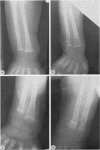Abstract
The skeletal changes in 19 very low birthweight infants (less than 1500 g) were observed from birth to 10 weeks, by means of clinical, biochemical, and radiological techniques. All infants were receiving a supplement of 800 IU vitamin D a day from age 2 weeks. None of the infants showed any specific physical sign of rickets during the period of study. Six infants showed radiological evidence of skeletal demineralisation; 1 of these had severe changes of rickets and 1 had both rickets and fractures. These 6 infants were of shorter gestational periods and lower birthweights than the infants not showing radiological changes. They tended to have more clinical problems and to reach a predetermined volume of feeds (160 ml/kg a day) later than the unaffected infants. Serum alkaline phosphatase values were significantly higher at 5 weeks in the infants with abnormal radiographs than in those without. There were no significant differences between the two groups in relation to serum calcium, inorganic phosphate, 25 hydroxyvitamin D, and immunoreactive parathyroid hormone. The pathogenesis of the skeletal lesions of very low birthweight infants remains unknown.
Full text
PDF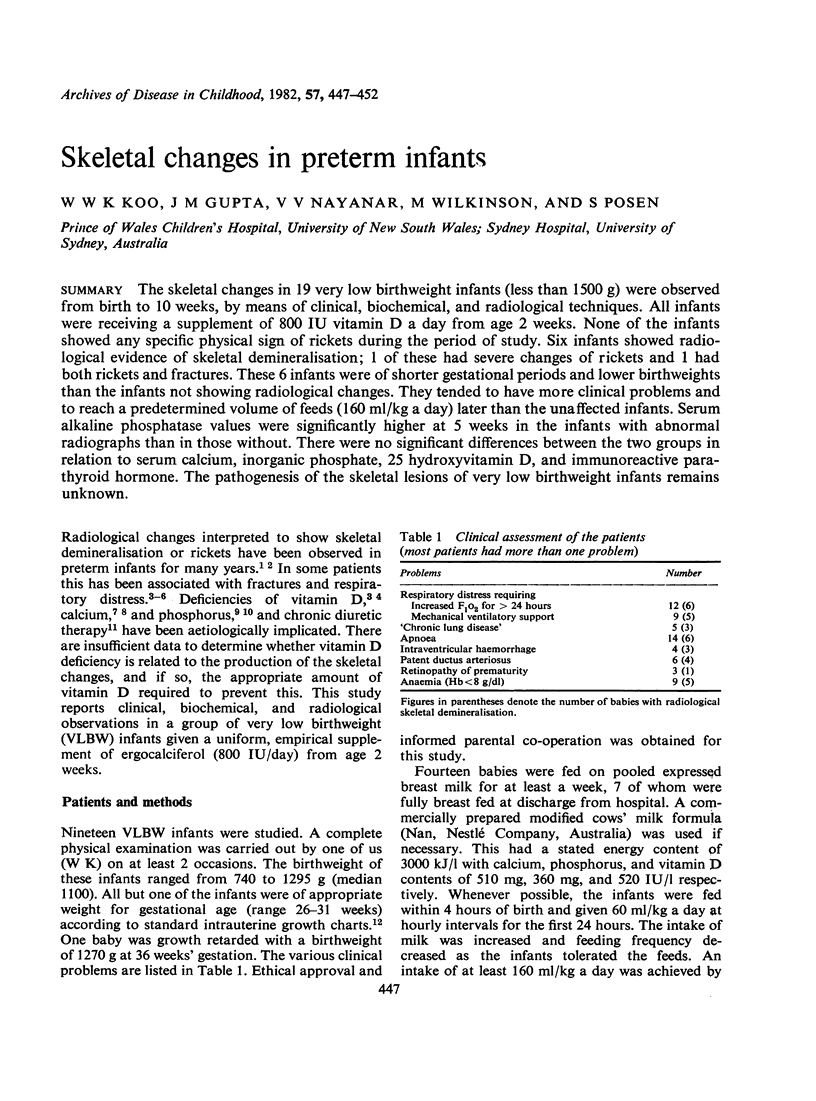

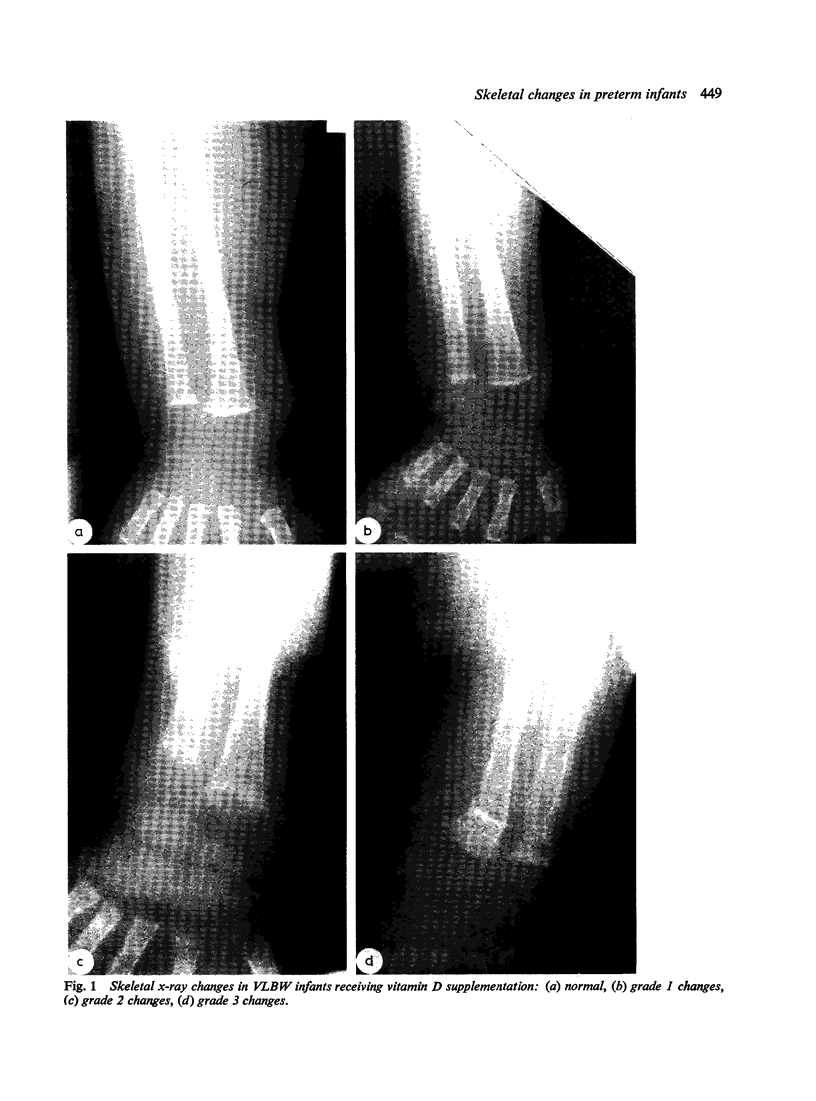
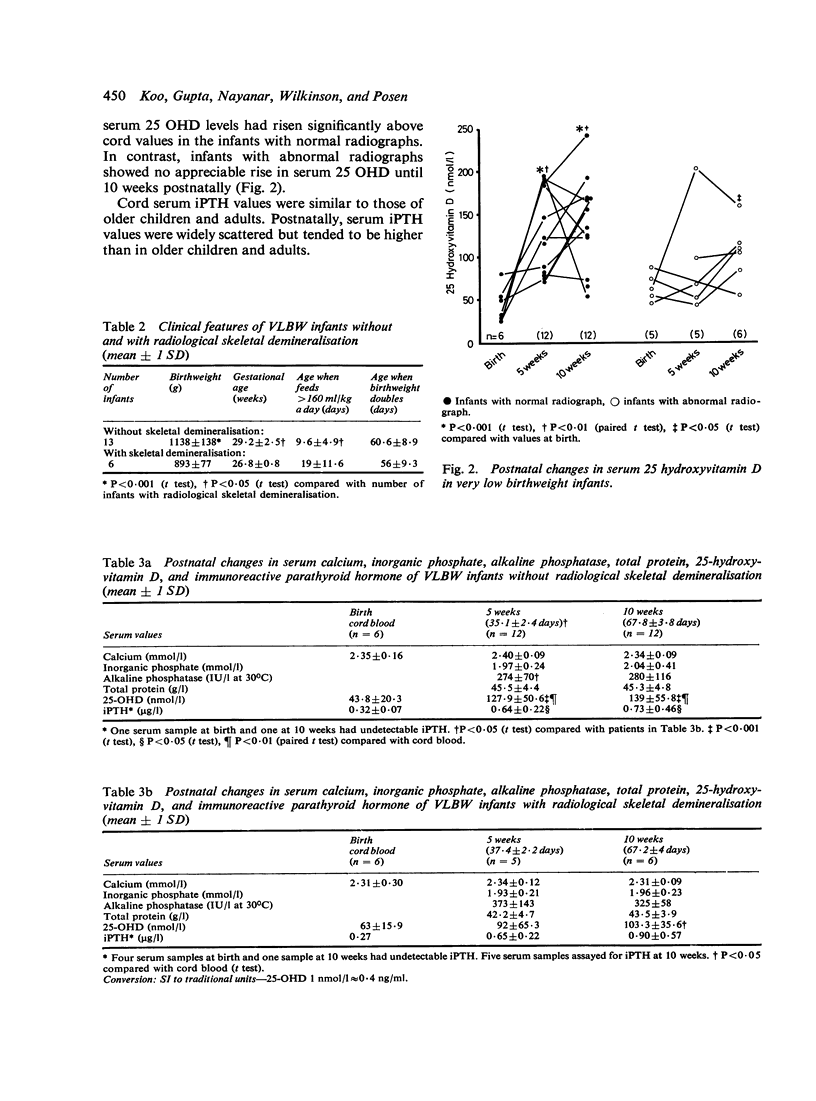
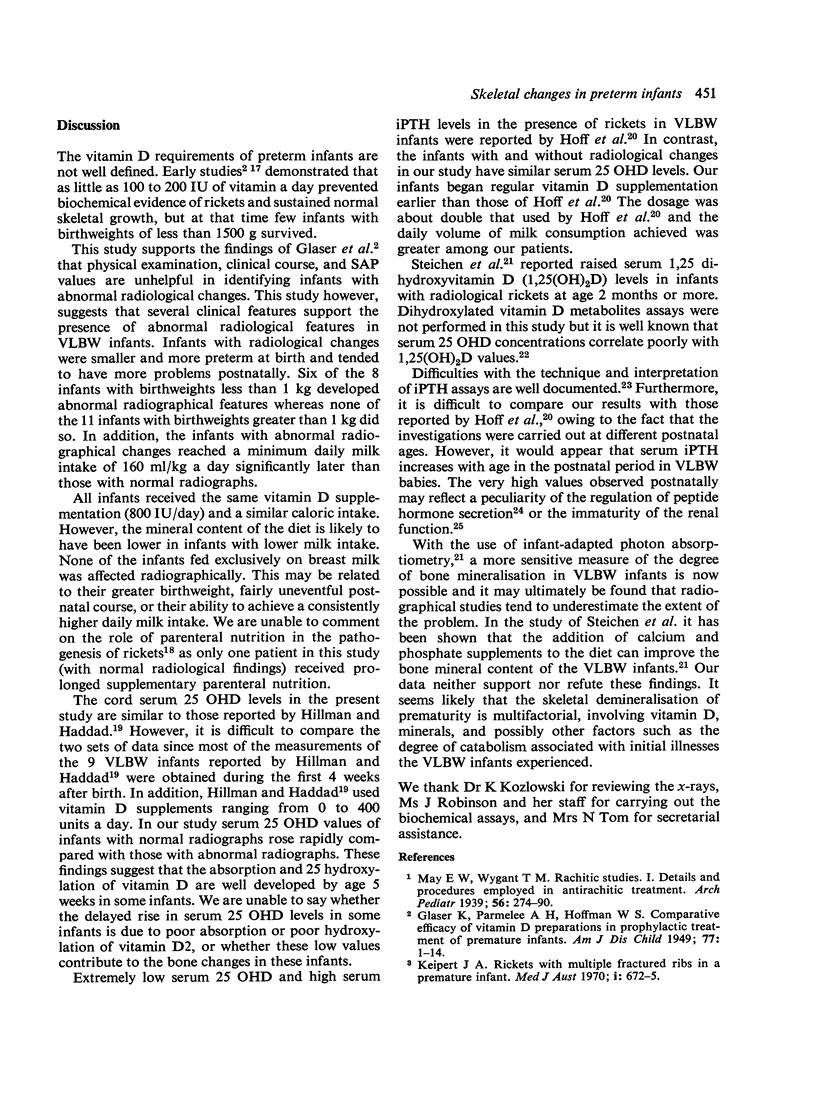
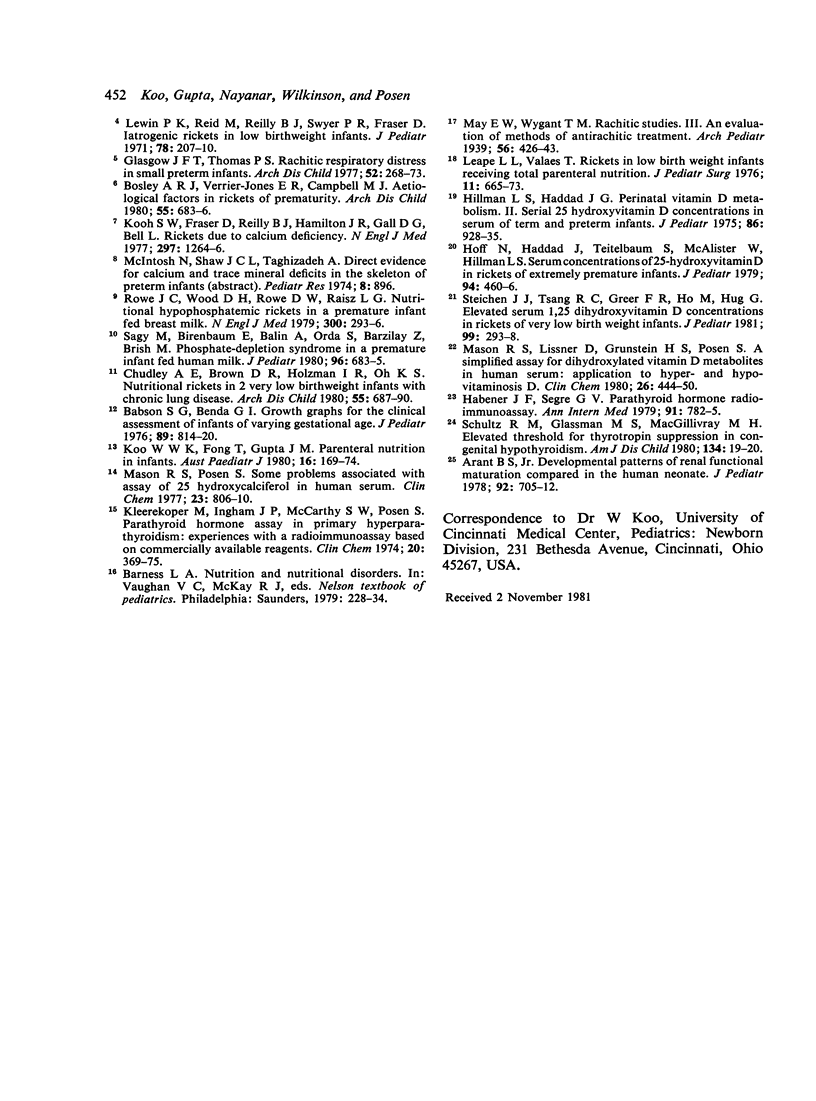
Images in this article
Selected References
These references are in PubMed. This may not be the complete list of references from this article.
- Arant B. S., Jr Developmental patterns of renal functional maturation compared in the human neonate. J Pediatr. 1978 May;92(5):705–712. doi: 10.1016/s0022-3476(78)80133-4. [DOI] [PubMed] [Google Scholar]
- Babson S. G., Benda G. I. Growth graphs for the clinical assessment of infants of varying gestational age. J Pediatr. 1976 Nov;89(5):814–820. doi: 10.1016/s0022-3476(76)80815-3. [DOI] [PubMed] [Google Scholar]
- Bosley A. R., Verrier-Jones E. R., Campbell M. J. Aetiological factors in rickets of prematurity. Arch Dis Child. 1980 Sep;55(9):683–686. doi: 10.1136/adc.55.9.683. [DOI] [PMC free article] [PubMed] [Google Scholar]
- Chudley A. E., Brown D. R., Holzman I. R., Oh K. S. Nutritional rickets in 2 very low birthweight infants with chronic lung disease. Arch Dis Child. 1980 Sep;55(9):687–690. doi: 10.1136/adc.55.9.687. [DOI] [PMC free article] [PubMed] [Google Scholar]
- Glasgow J. F., Thomas P. S. Rachitic respiratory distress in small preterm infants. Arch Dis Child. 1977 Apr;52(4):268–273. doi: 10.1136/adc.52.4.268. [DOI] [PMC free article] [PubMed] [Google Scholar]
- Habener J. F., Segre G. V. Parathyroid hormone radioimmunoassay. Ann Intern Med. 1979 Nov;91(5):782–785. doi: 10.7326/0003-4819-91-5-782. [DOI] [PubMed] [Google Scholar]
- Hillman L. S., Haddad J. G. Perinatal vitamin D metabolism. II. Serial 25-hydroxyvitamin D concentrations in sera of term and premature infants. J Pediatr. 1975 Jun;86(6):928–935. doi: 10.1016/s0022-3476(75)80231-9. [DOI] [PubMed] [Google Scholar]
- Hoff N., Haddad J., Teitelbaum S., McAlister W., Hillman L. S. Serum concentrations of 25-hydroxyvitamin D in rickets of extremely premature infants. J Pediatr. 1979 Mar;94(3):460–466. doi: 10.1016/s0022-3476(79)80602-2. [DOI] [PubMed] [Google Scholar]
- Keipert J. A. Rickets with multiple fractured ribs in a premature infant. Med J Aust. 1970 Mar 28;1(13):672–675. doi: 10.5694/j.1326-5377.1970.tb116914.x. [DOI] [PubMed] [Google Scholar]
- Kleerekoper M., Ingham J. P., McCarthy S. W., Posen S. Parathyroid hormone assay in primary hyperparathyroidism: experiences with a radioimmunoassay based on commercially available reagents. Clin Chem. 1974 Mar;20(3):369–375. [PubMed] [Google Scholar]
- Koo W. W., Fong T., Gupta J. M. Parenteral nutrition in infants. Aust Paediatr J. 1980 Sep;16(3):169–174. doi: 10.1111/j.1440-1754.1980.tb01288.x. [DOI] [PubMed] [Google Scholar]
- Kooh S. W., Fraser D., Reilly B. J., Hamilton J. R., Gall D. G., Bell L. Rickets due to calcium deficiency. N Engl J Med. 1977 Dec 8;297(23):1264–1266. doi: 10.1056/NEJM197712082972307. [DOI] [PubMed] [Google Scholar]
- Leape L. L., Valaes T. Rickets in low birth weight infants receiving total parenteral nutrition. J Pediatr Surg. 1976 Oct;11(5):665–674. doi: 10.1016/0022-3468(76)90088-9. [DOI] [PubMed] [Google Scholar]
- Lewin P. K., Reid M., Reilly B. J., Swyer P. R., Fraser D. Iatrogenic rickets in low-birth-weight infants. J Pediatr. 1971 Feb;78(2):207–210. doi: 10.1016/s0022-3476(71)80002-1. [DOI] [PubMed] [Google Scholar]
- Mason R. S., Lissner D., Grunstein H. S., Posen S. A simplified assay for dihydroxylated vitamin D metabolites in human serum: application to hyper- and hypovitaminosis D. Clin Chem. 1980 Mar;26(3):444–450. [PubMed] [Google Scholar]
- Mason R. S., Posen S. Some problems associated with assay of 25-hydroxycalciferol in human serum. Clin Chem. 1977 May;23(5):806–810. [PubMed] [Google Scholar]
- Rowe J. C., Wood D. H., Rowe D. W., Raisz L. G. Nutritional hypophosphatemic rickets in a premature infant fed breast milk. N Engl J Med. 1979 Feb 8;300(6):293–296. doi: 10.1056/NEJM197902083000607. [DOI] [PubMed] [Google Scholar]
- Sagy M., Birenbaum E., Balin A., Orda S., Barzilay Z., Brish M. Phosphate-depletion syndrome in a premature infant fed human milk. J Pediatr. 1980 Apr;96(4):683–685. doi: 10.1016/s0022-3476(80)80740-2. [DOI] [PubMed] [Google Scholar]
- Schultz R. M., Glassman M. S., MacGillivray M. H. Elevated threshold for thyrotropin suppression in congenital hypothyroidism. Am J Dis Child. 1980 Jan;134(1):19–20. doi: 10.1001/archpedi.1980.02130130011004. [DOI] [PubMed] [Google Scholar]
- Steichen J. J., Tsang R. C., Greer F. R., Ho M., Hug G. Elevated serum 1,25 dihydroxyvitamin D concentrations in rickets of very low-birth-weight infants. J Pediatr. 1981 Aug;99(2):293–298. doi: 10.1016/s0022-3476(81)80481-7. [DOI] [PubMed] [Google Scholar]



